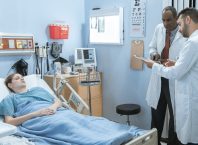Table of Contents
Practically any well-meaning, responsible healthcare institution aims to boost its quality of care. Otherwise, it will immediately defeat its purpose and will result in, more often than not, an unsatisfied public.
This reason underlines the need for medical establishments to look for more effective ways to boost their level of patient care.
With the help of present-day technology, they really don’t run out of options and routes available. Disease management software alone can already bring about numerous desirable changes in any given healthcare system.
To demonstrate this, we have outlined all the ways RPM can help, specifically with the data derived from it.
Why Data Collection Plays an Integral Role in Healthcare
Many major industries benefit from Big Data, particularly the quantitative and qualitative aspects of data collection. The insights into patient data afforded in healthcare are nothing short of life-saving.
With the right data, adequate treatment can be provided immediately and can actively help in promoting health.
Health deterioration, in turn, is effectively prevented, leading to a better quality of life – which is the end-goal of all healthcare. Many people tend to just highlight the benefits of RPM data on patients.
But, obviously, they go well beyond just how the treatment of patients can be directly improved.
Other factors play a role in improving patient care, after all, with regards to data. How it benefits the entire organizational setup of a healthcare system also deserves taking note.
That said, we are long past the point when data just played a secondary role in improving the functions of a given industry. We need only to look at the way it benefits patient care in medical industries to see why.
The Ways RPM Data Greatly Boost Patient Care
We already mentioned that data collection can change healthcare systems for the better.
But how exactly does it achieve this via remote patient management?
Why is it often touted by its advocates as a bringer of unprecedented value in terms of patient care?
We will answer these main questions with the facts we have shared below.
RPM provides newer, better insights via its data quality.
The technology’s superiority stems from the fact that the patient data acquired from the remote patient management software is often of immense value – value that can’t be rivaled by past care models.
It’s not just limited to the quality of the data but the quantity as well. There has never been any other point in the history of medicine that this much high-quality patient data can be acquired. And what makes things even better is that the data collection and sharing can be done with equally unprecedented velocity, as in the case of the HealthArc RPM software.
With the help of this vastly superior data, medical personnel will always manage to learn the best course of action to take in treatment. After all, diagnoses become more accurate, and more data about the patient is made available on hand. RPM, in short, equips physicians with better data, those that will help them perform their duties better and quicker.
It’s already been proven before that delays in the acquisition of data can result in unfavorable outcomes for patients. These outcomes could be avoided with proper utilization of RPM.
RPM software is designed to get the patient involved in the treatment
Healthcare, one way or another, also needs the involvement of the patient to ensure its success. How can you get the patient involved if data is lacking? With remote patient monitoring, data collection and dispensation is rarely an issue.
RPM software like HealthArc is also very laudable for the effort they take in making their platform intuitive. This way, both the patient and healthcare provider won’t have a hard time getting used to relying on it for the entire duration of the treatment.
And those are just some of the features of RPM that makes it such an invaluable addition to any healthcare system. Practically nothing is held back from the patient, heightening transparency.
Such scenarios only pave the way to better opportunities to build trust. Trust, of course, forms the cornerstone of any patient-doctor relationship, which, in turn, greatly impacts patient care.
We can also add to this the fact that RPM software also encourages the patient to be actively involved with treatment. Some software even offers patients incentives when they engage in promoting their health. Without a doubt, such proactive approaches lead to better healthcare outcomes.
It also solves plenty of common organizational issues
Organizational challenges that also hold back healthcare systems evidently affect patient care, too. Burdens from workloads can be relieved with the help of RPM. Basically any type of healthcare system with a staff that is not overburdened will be able to guarantee optimal patient care.
We can immediately see this point’s veracity at the opposite end of the spectrum: in healthcare institutions and clinics that have since buckled and fallen under the immense pressure of nearly impossible workloads. With an optimized administrative system in place, common issues like burnouts and dips in staff morale can be avoided. HealthArc even makes good use of automation to further reduce the load on them and streamline key organizational processes.
Chronic disease management software is designed with these factors in mind. They offer direct solutions. And this fact only exhibits the comprehensive advantages RPM brings to the table.
Cementing Remote Patient Monitoring’s Place in Driving Healthcare Growth
To improve patient care, it has always been recommended by present-day health experts to look towards innovation. Understandably, newer technologies need plenty of testing and only a handful can be deemed as cost-efficient.
This fact only underscores what makes RPM very unique – it fulfills both criteria. In short, it more than deserves its recognition as an innovation, well-suited for tackling the healthcare problems of tomorrow.
Conclusion
Improving patient care is a continuous process for healthcare industries. It’s innately tied to the industry since it’s one of the main reasons why they’ve been established in the first place. Considering the benefits stated above, RPMs obviously represent all that is exceptional in telemedicine technology.
With that said, it’s high time for hospitals and health practitioners around the world to realize the immense value it brings when it comes to improving patient care.
Who knows what other improvements would be introduced to remote patient monitoring software in the future?
Since these platforms are built with scalability in mind, it goes without saying that healthcare systems have a lot to look forward to in telemedicine.



